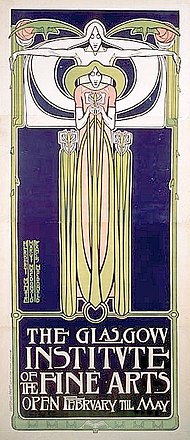
The Modern Style is a style of architecture, art, and design that first emerged in the United Kingdom in the mid-1880s. It was the first Art Nouveau style worldwide, and it represents the evolution of the Arts and Crafts movement which was native to Great Britain. The Modern Style provided the base and intellectual background for the Art Nouveau movement and was adapted by other countries, giving birth to local variants such as Jugendstil and the Vienna Secession. It was cultivated and disseminated through the Liberty department store and The Studio magazine.
The most important person in the field of design in general, and architecture in particular, was Charles Rennie Mackintosh. He created one of the key motifs of the movement, now known as the "Mackintosh rose" or "Glasgow rose". The Glasgow School circle was also of tremendous importance, particularly the group closely associated with Mackintosh known as "The Four". The Liberty store's nurturing of style gave birth to two metalware lines, Cymric and Tudric, designed by Archibald Knox. In the field of ceramic and glass Christopher Dresser is a standout figure: not only did he work with the most prominent ceramic manufacturers but became a crucial person behind James Couper & Sons' trademarking of Clutha glass, inspired by ancient Rome, in 1888. Aubrey Beardsley was a defining person in graphic design and drawing, and influenced painting and style in general. In textiles William Morris and C. F. A. Voysey are of huge importance, influencing them all to an extent, although most artists were versatile and worked in many mediums and fields. Because of the evolution of Arts and Crafts to Modern Style, lines can be blurred and many designers, artists, and craftspeople worked in both styles simultaneously. Important figures include Charles Robert Ashbee, Walter Crane, Léon-Victor Solon, George Skipper, Charles Harrison Townsend, Arthur Mackmurdo, William James Neatby.
